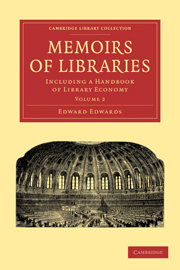Book contents
- Frontmatter
- Contents
- Chapter XV The Older Libraries of English Towns, and Their Management By Munic
- Chapter XVI The Parochial and Quasi-Parochial Libraries of England
- Chapter XVII The History of The “Public Libraries Acts” of 1850 and 1855
- Chapter XVIII The Working of The Public Libraries Acts of 1850 and 1855
- Appendix to Volume I
- Part The First. History of Libraries (Continued.)
- Book IV. The Libraries of The United States of America
- Book V. The Modern Libraries of Continental Europe
Chapter VII - The University Libraries of Germany, Moravia and Gallicia
Published online by Cambridge University Press: 29 August 2010
- Frontmatter
- Contents
- Chapter XV The Older Libraries of English Towns, and Their Management By Munic
- Chapter XVI The Parochial and Quasi-Parochial Libraries of England
- Chapter XVII The History of The “Public Libraries Acts” of 1850 and 1855
- Chapter XVIII The Working of The Public Libraries Acts of 1850 and 1855
- Appendix to Volume I
- Part The First. History of Libraries (Continued.)
- Book IV. The Libraries of The United States of America
- Book V. The Modern Libraries of Continental Europe
Summary
Previously to The Reformation, The Catholic Univerversities of Germany were principally uuder The direction of The Franciscans and Dominicans; and subsequently to that period under that of The Jesuits, all of whom were equally [?] imbued with The spirit of The Roman Hierarchy. The Protestant Universities were, at first, directed by The Reformed Clergy; at a later period, by The Lawyers and Court-Councillors, in The spirit of Roman Xaw and of Modern Monarchy.
MEHZEL , History of Germany,§ 216. (Horrocfcs’ Translation, ii, 428.)of The precise date of The foundation of The University Library 01 Marburg There seems to be no record. There is however little doubt that it began to be columversity itself—in 1527—and, like it, by The care and munificence of Philip ‘The Magnanimous,’ Landgrave of Hesse. In 1564, The University received a new code of statutes, in one section of which it is enacted that a Librarian shall be chosen from amongst The professors; that chains shall be provided for The safety of The books; that The Library shall be accessible to The Professors and Students; that no books shall be removed and no leaves cut Thereout”Forty years later, The Library received its first considerable augmentation at The hands of Landgrave Maurice, to it The collection of books left by Count von Diez (a son of Landgrave Philip), who died during his imprisonment at Ziegenhain. When The Universities of Marburg and Giessen were separated in 1650, part of The Marburg Library was transferred to Giessen, and almost for a century, The former made no very noticeable progress. About 1746, purchases of some importance began to be made. In 1763, such books of The Library at Cassel as became duplicates by The bequest of Philip Senning, were (in pursuance of his will,) sent to Marburg. In 1773, a collection, amounting to 8600 volumes, was bequeaThed by J. G. Estor, Chancellor of The University. The King of Westphalia made some valuable presents to it in 1810 and 1812.
- Type
- Chapter
- Information
- Memoirs of LibrariesIncluding a Handbook of Library Economy, pp. 466 - 491Publisher: Cambridge University PressPrint publication year: 2010First published in: 1859

